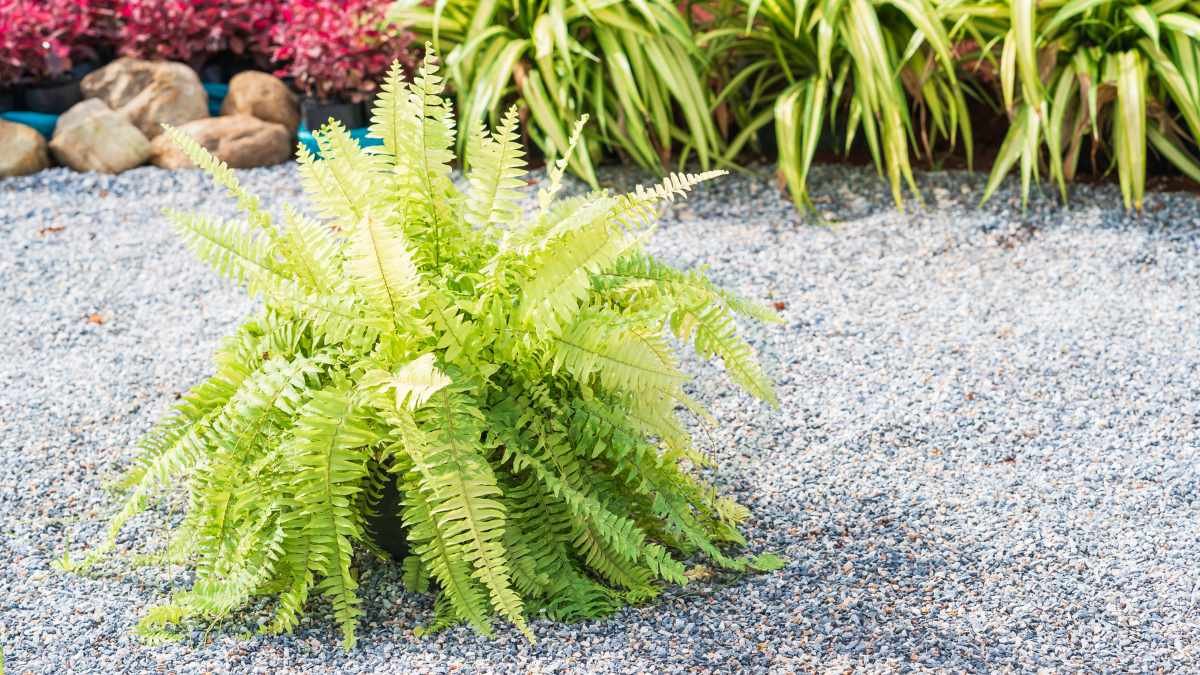
Can you plant ferns in the ground? Absolutely! Planting ferns in the ground can be a rewarding experience, adding lush greenery, foliage, and natural beauty to your garden or landscape. Whether you're a seasoned gardener or a beginner, growing ferns in the ground is a relatively straightforward process that can yield stunning results.
Ferns are versatile plants that thrive in various conditions, from deep shade to partial sunlight. Before planting, it's essential to choose the right species of outdoor ferns for your specific environment, considering factors such as soil type, moisture levels, and light exposure. Once you've selected the perfect spot, prepare the soil by adding organic matter to improve drainage and fertility. Dig a hole slightly larger than the fern's root ball, gently place the plant in the hole, and backfill with soil, ensuring the crown is level with the ground. Water thoroughly after planting, and maintain consistent moisture to support healthy growth. With proper care, your ferns will flourish in the ground, enhancing the natural beauty of your outdoor space.
If you're eager to learn more about planting ferns in the ground, there's a wealth of information available to explore. From selecting the ideal species for your climate to implementing advanced care techniques, delving deeper into the world of fern gardening can unlock endless possibilities for creating a vibrant and thriving landscape.
Key Takeaways
- Planting Ferns: You can plant ferns in the ground by understanding their needs and choosing the right location.
- Timing Matters: Plant ferns during the appropriate season to promote healthy growth and establishment.
- Location Selection: Select a shaded, moist area with well-draining soil for optimal fern growth.
- Proper Planting: Follow the correct planting process, ensuring proper depth and spacing for each fern.
- Watering Needs: Maintain consistent moisture levels for ferns, avoiding both drought and waterlogging.
- Regular Maintenance: Monitor for pests, diseases, and soil conditions to keep ferns healthy and thriving.
Understanding Ferns
Types Varieties
Fern plants come in various types, including Lady Fern, Ostrich Fern, and Cinnamon Fern. These ferns boast unique characteristics that set them apart. Popular varieties like Maidenhair and Japanese Painted Fern are well-loved for their distinct features. The diversity in heights is striking, with fern plants ranging from just a few inches to towering at 6 feet tall.
Growth Habits
Ferns reproduce through spores found beneath their leaves, showcasing a fascinating aspect of their life cycle. These plants have the remarkable ability to grow to significant heights, making them excellent choices for adding texture and color to gardens. Ferns thrive best in woodland gardens that offer partial shade, reflecting their natural habitat preferences.
Soil Preferences
Moist but not overly wet soil is crucial for the successful growth of ferns. These plants thrive in acidic soil conditions, emphasizing the need for specific soil pH levels for optimal development. Different types of ferns may react differently to freezing temperatures, highlighting the importance of understanding each variety's specific requirements.
Planting Time

Best Seasons
Plant ferns in spring for optimal growth, as they thrive in the moderate temperatures and increased daylight. Avoid planting during extreme weather, such as harsh winters or scorching summers. Select fern varieties that are well-suited to your region's climate for better adaptation.
When heavy rainfall occurs, it can lead to waterlogged soil, causing root rot in ferns. Monitor moisture levels during periods of excess humidity to prevent overwatering. Ensure proper drainage to avoid water accumulation around the roots.
Consider bringing ferns indoors during extreme weather conditions to protect them from potential damage. Provide adequate light and maintain appropriate humidity levels inside to mimic their natural habitat. Adjust watering frequency based on indoor conditions.
Weather Conditions
Excessive rainfall can result in waterlogging, leading to root rot in ferns. Adequate drainage is crucial to prevent this issue. Monitor moisture levels regularly and adjust watering accordingly.
During periods of high humidity, ensure proper ventilation around the ferns to prevent fungal diseases. Avoid overcrowding plants to promote air circulation, reducing the risk of mold and mildew formation.
When facing extreme weather conditions like storms or heatwaves, consider moving potted ferns indoors temporarily for protection. Place them near windows for sufficient light exposure and monitor their condition closely.
Selecting Location
Light Requirements
Ferns suffer damage from too much sun, leading to wilting and browning of leaves. Planting in shaded areas fosters healthy growth. Tall trees provide filtered light, mimicking a woodland environment that ferns thrive in.
Soil Conditions
Before planting, test soil quality to ensure it's suitable for ferns. Maintaining optimal moisture levels is crucial for their well-being. Plant ferns at the right depth in the soil to promote strong root development.
Planting Process

Digging Holes
Dig holes the same size as the fern pot to ensure a snug fit for planting. Proper technique involves gently removing the fern from its pot and placing it at ground level. Good drainage is crucial for healthy fern growth, preventing waterlogging and root rot.
When planting ferns, dig holes that match the size of their pots. This ensures a smooth transition for the plant into the ground. Ensure adequate drainage by adding gravel or sand at the bottom of the hole before planting.
Spacing Ferns
Maintain optimal spacing between fern plants to promote healthy growth. Proper spacing prevents overcrowding, allowing each plant to access sunlight and nutrients efficiently. Guidelines for spacing depend on the mature size of different fern species.
To prevent competition for resources, space ferns adequately based on their mature size. Proper spacing encourages optimal air circulation and prevents diseases caused by overcrowding. Consider leaving ample room between plants to accommodate their growth.
Outdoor Cultivation
Garden Integration
Ferns can enhance garden landscapes by adding a touch of natural beauty. They thrive in shady areas, making them perfect for gardens with limited sunlight. Incorporating ferns in your garden can create a lush and vibrant atmosphere that is both calming and visually appealing.
In predominantly shady garden areas, ferns serve as excellent ground cover, filling spaces with their elegant fronds. Their presence not only softens the landscape but also provides a unique contrast to other plants. By planting ferns strategically, you can achieve a balanced and harmonious garden design.
Adding ferns to garden landscapes introduces a diverse range of textures and shapes. The intricate patterns of fern leaves can bring a sense of depth and interest to your outdoor space. Whether used as borders or focal points, ferns play a crucial role in enhancing the overall aesthetics of the garden.
Landscape Design
To create a natural look in your landscape design, consider mixing different types of ferns to add depth and dimension. Combining large and small varieties can create an interesting visual effect that mimics the diversity found in nature. Ferns are versatile plants that can be used to fill gaps between other plants, creating a cohesive and seamless look.
When planning your garden layout, think about how ferns can complement the existing flora. Their graceful foliage can provide a striking contrast to bold flowers or sturdy shrubs, adding an element of graceful elegance to the overall design. By strategically placing ferns throughout your garden, you can achieve a harmonious balance between different plant species.
The versatility of ferns makes them suitable for various garden styles, from formal to wild and rustic designs. Whether you prefer a structured layout or a more organic arrangement, ferns can adapt to different environments with ease. Their ability to thrive in diverse conditions makes them an ideal choice for enhancing the visual appeal of any garden setting.
Watering Ferns
Frequency
Ferns require regular watering to thrive, typically needing moisture consistently. Monitor soil moisture levels by feeling the soil with your fingers. Adjust watering frequency according to weather, watering more during hot and dry periods.
Plant ferns in well-draining soil to prevent waterlogging, which can lead to root rot. Overwatering can be detrimental to ferns, causing wilting and yellowing of leaves. Underwatering can also harm ferns, leading to stunted growth and leaf loss.
- Pros: Consistent watering promotes healthy growth.
- Cons: Overwatering can cause root rot.
Techniques
When planting ferns, ensure the soil is rich in organic matter and has good drainage. Transplant ferns carefully if needed, ensuring minimal disturbance to the roots. Following proper planting techniques is crucial for successful fern cultivation.
Proper planting depth is essential; plant ferns at the same level they were previously growing. Mulching around ferns helps retain moisture while preventing weeds. Regularly check for pests and diseases that may affect fern health.
- Plant ferns in shady areas with indirect sunlight.
- Water deeply but infrequently to avoid waterlogged soil.
- Transplant ferns during their dormant season for minimal stress on plants.
Maintenance Tips
Mulching
Mulching around fern plants offers various benefits. It helps retain moisture in the soil, crucial for ferns' growth. Mulch aids in regulating soil temperature, creating a stable environment for the plants. When choosing mulch for ferns, opt for organic materials like compost or shredded leaves.
Pruning dead fronds is essential for maintaining fern health. Pruning promotes new growth and enhances the overall appearance of the plant. To ensure optimal results, prune ferns during their dormant season using sharp scissors or pruning shears.
Pruning
Pruning plays a vital role in maintaining healthy ferns. By removing dead fronds, you allow space for new growth to thrive. Proper pruning techniques not only enhance the plant's aesthetics but also prevent diseases by eliminating decaying foliage.
- Selectively prune dead or damaged fronds to encourage healthy growth.
- Regularly inspect your ferns and trim any discolored or withered fronds promptly.
Common Challenges
Pests Diseases
Fern plants are susceptible to common pests such as aphids, mealybugs, and spider mites. These pests can cause damage by feeding on the plant's leaves and draining its nutrients. To protect ferns, regularly inspect the leaves for any signs of pest infestations.
Implement preventive measures like spraying insecticidal soap or neem oil to deter pests. Maintaining proper air circulation around the plants can help prevent pest buildup. Early detection is crucial; promptly address any signs of pest activity to prevent widespread infestations.
Environmental Stressors
Environmental stressors like extreme temperatures and high humidity levels can negatively impact fern growth. Extreme heat can lead to wilting and browning of fronds, while excessive moisture can promote fungal diseases. Ensure ferns are placed in areas with filtered sunlight and adequate airflow.
Mitigate environmental stressors by watering ferns correctly; avoid over-watering to prevent root rot. During hot weather, consider misting the foliage to increase humidity levels. Properly mulching around the plants can also help regulate soil temperature and moisture levels for optimal growth.
Ensuring Growth
Fertilization
Fertilization plays a crucial role in promoting healthy fern growth by providing essential nutrients like nitrogen, phosphorus, and potassium. These nutrients aid in leaf development and overall plant vigor. Organic fertilizers, such as compost or manure, are ideal for ferns as they release nutrients slowly and improve soil structure.
When it comes to fertilizing fern plants, it is recommended to apply fertilizer sparingly to prevent nutrient imbalances that can harm the plants. Fertilize ferns during the growing season, typically from spring to early fall, to support active growth.
Monitoring Health
Regularly monitoring the health of fern plants is crucial for detecting issues early and ensuring optimal growth. Signs of stress or nutrient deficiencies in ferns include yellowing fronds, stunted growth, or leaf discoloration. These indicators signal the need for immediate attention.
To maintain the health of ferns, take corrective actions such as adjusting watering practices or applying suitable fertilizers based on the specific deficiency observed. Proper watering habits, adequate light exposure, and proper drainage are also vital factors in maintaining healthy ferns.
Final Remarks
Now that you have a solid understanding of planting ferns in the ground, it's time to put your knowledge into action. Remember the key steps: selecting the right location, following the planting process, and providing proper care and maintenance. By ensuring you meet these criteria, you are setting your ferns up for success in their outdoor cultivation. Despite common challenges, with dedication and attention to detail, you can guarantee the growth and flourishing of your ferns in your garden.
Take the next step by applying what you've learned today. Get your hands dirty, plant those ferns, and watch them thrive under your care. Share your successes and challenges with fellow gardeners to create a community of support and knowledge exchange. Your lush fern garden awaits!
Frequently Asked Questions
Can ferns be planted directly in the ground?
Yes, ferns can be planted directly in the ground as long as the soil is well-draining and rich in organic matter. Ensure the location provides adequate shade and moisture for optimal growth.
What is the best time to plant ferns?
The best time to plant ferns is during the spring or fall when temperatures are milder. This allows the plants to establish their roots before facing extreme weather conditions.
How do I select the ideal location for planting ferns?
Choose a shaded area with indirect sunlight and moist, well-drained soil. Avoid areas with direct sunlight or strong winds, as ferns prefer a cool and humid environment for healthy growth.
What is the process of planting ferns in the ground?
Dig a hole slightly larger than the root ball of the fern, place it in the hole at the same depth it was previously growing, backfill with soil, and water thoroughly. Mulch around the plant to retain moisture.
How often should I water outdoor ferns?
Water outdoor ferns regularly to keep the soil consistently moist but not waterlogged. Check the soil moisture levels frequently, especially during hot and dry periods, and adjust your watering schedule accordingly.
Image Source: Paid image from CANVA





